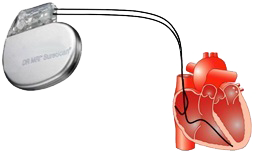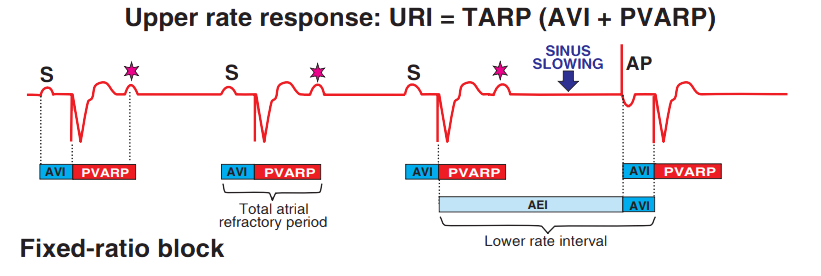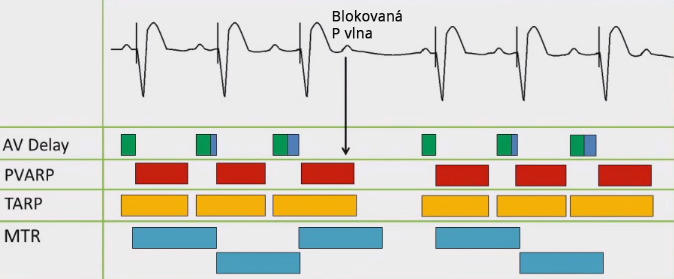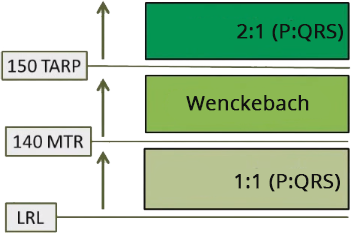Home /
Upper Rate Behavior of DDD Pacemaker
Upper rate response of DDD pacemakers
URL (Upper rate limit)
- Is the maximum frequency at which the pacemaker can track P waves to the ventricles (P wave tracking)
- Sometimes referred to as maximum tracking rate (MTR)
- URL protects the ventricles from tachycardia
- For example, during atrial fibrillation, impulses from the atria could be transmitted to the ventricles at a rate of 350-600/min.

DDD pacemaker (ApVp)
- The dual-chamber pacemaker has a DDD mode (ApVp)
- URL (Upper rate limit)
- Is the maximum frequency at which the pacemaker can track P waves to the ventricles (P wave tracking)
- If the P waves have a higher frequency than the URL, upper rate behavior is activated
PVARP (Post ventricular atrial refractory period)
- PVARP (Post ventricular atrial refractory period)

DDD pacemaker (ApVp)
- The dual-chamber pacemaker has a DDD mode (ApVp)
- PVARP (Post ventricular atrial refractory period)
- Is the period after ventricular pacing (or sensing) during which an atrial signal cannot trigger AV conduction
- Prevents sensing of retrograde P waves or atrial extrasystoles
- VRP (Ventricular refractory period)
- Is the period after ventricular sensing (or pacing)
- The pacemaker ignores sensing during VRP
- Prevents sensing of the T wave
TARP (Total atrial refractory period)
- TARP = AV interval + PVARP
- TARP is the total refractory period for atrial sensing
- A P wave that occurs during TARP will not be transmitted to the ventricles (no QRS complex will occur)
- TARP determines the highest frequency of P waves that can be transmitted to the ventricles before a 2:1 block occurs

DDD pacemaker (AsVp)
- The dual-chamber pacemaker has a DDD mode (AsVp)
- AV delay (AV interval)
- It is the interval between atrial pacing (sensing) and ventricular pacing (sensing)
- PVARP (Post ventricular atrial refractory period)
- It is the period after ventricular pacing (sensing) during which an atrial signal cannot trigger AV conduction
- Prevents sensing of retrograde P waves or atrial extrasystoles
- TARP (Total atrial refractory period)
- TARP = AV interval + PVARP
- It is the refractory period for atrial sensing
- The atrial electrode ignores sensing during TARP
- A P wave that occurs during TARP will not be transmitted to the ventricles
- A 2:1 AV block occurs
- Every second P wave is blocked due to the TARP period
Upper rate behavior

- A dual-chamber pacemaker has a defined URL interval
- This is the maximum frequency of P waves
- that the pacemaker transmits to the ventricles
- Upper rate behavior
- It is activated when the frequency of intrinsic P waves exceeds the URL
- This is a programmed response of the pacemaker
- It is not a pacemaker malfunction
- It can occur only in DDD mode (AsVp) - P wave tracking
- Upper rate behavior can respond in three ways
Pacemaker 2:1 Block

Pacemaker 2:1 block, DDD pacemaker (AsVp)
- A dual-chamber pacemaker in DDD mode (AsVp)
- AV delay (AV interval)
- This is the interval between atrial pacing (sensing) and ventricular pacing (sensing)
- PVARP (Post ventricular atrial refractory period)
- This is the period after ventricular pacing (sensing) when the atrial signal cannot trigger AV conduction
- It serves to prevent sensing of retrograde P waves or atrial extrasystoles
- TARP (Total atrial refractory period)
- TARP = AV interval + PVARP
- This is the refractory period of atrial sensing
- The atrial electrode ignores sensing during TARP
- A P wave occurring during TARP will not be transmitted to the ventricles
- Resulting in a 2:1 AV block
- Every second P wave is blocked due to the TARP period
- MTR (Maximum tracking rate) = URL (Upper rate limit)
- This is the maximum frequency at which the pacemaker can transmit P waves to the ventricles
Frequency Before 2:1 Block
- Based on the defined pacemaker intervals, the following can be calculated
- Threshold frequency before 2:1 block
- Example:
- AV interval: 200ms
- PVARP: 300ms
- TARP: 500ms (AV interval + PVARP)
- Frequency: 60,000/500ms = 120/min.
- If the frequency of P waves < 120/min. then the conduction to the ventricles is 1:1
- If the frequency of P waves > 120/min. then the conduction to the ventricles is 2:1

DDD Pacemaker
- Dual-chamber pacemaker in DDD mode
- SA node generates impulses regularly
- Initially, there is sensing of intrinsic P waves (S)
- Which are transmitted to the ventricles through the AV interval
- Every second P wave occurs during the PVARP (asterisk) and is blocked
- This results in a 2:1 block on the ECG
- At the end, the SA node slows down and atrial pacing is activated
- Because no intrinsic P wave occurs during the escape interval
- The pacemaker ignores the P wave during the PVARP
- AP is a stimulated P wave, thus it has a different shape than intrinsic P waves
- When the SA node frequency slows down, the 2:1 block disappears
Pacemaker Wenckebach

Pacemaker Wenckebach (mode DDD: AsVp)
- Dual-chamber pacemaker in DDD mode (AsVp)
- Can occur only if MTR is longer than the TARP interval
- With increasing P wave frequency
- P waves shift into the MTR interval
- If there is a positive sensing of P waves during the MTR interval
- Then ventricular pacing follows only after the end of the MTR interval
- Not after the end of the AV interval (red arrow)
- The AV interval thus prolongs (W)

Pacemaker Wenckebach (4:3), DDD mode: AsVp
- The dual-chamber pacemaker operates in DDD mode (AsVp)
- The SA node is intact
- It generates impulses regularly (the PP interval does not change)
- First P wave
- It is transmitted to the ventricles, causing ventricular pacing at the end of the AV interval
- Second P wave
- It occurs during the MTR interval
- The AV interval extends, and ventricular pacing occurs exactly at the end of the MTR interval
- Third P wave
- It occurs even earlier during the MTR interval
- The AV interval extends even more, and ventricular pacing occurs exactly at the end of the MTR interval
- Fourth P wave
- It occurs during the TARP interval (black arrow)
- This P wave is completely blocked
- After the blocked P wave, the cycle repeats
- The PQ interval gradually lengthens until a P wave is blocked

Pacemaker Wenckebach (4:3), DDD mode: AsVp
- The dual-chamber pacemaker operates in DDD mode (AsVp)
- SAI (Spontaneous atrial interval)
- The spontaneous activity of the SA node is
- Shorter than the URI, but longer than the TARP
- The PQ interval gradually lengthens
- And every 4th P wave is blocked, because it occurs during the PVARP
- URI (Upper rate interval) = MTR (Maximum tracking rate)
SA Node Frequency and DDD Pacemaker
- With a rising frequency of intrinsic P waves
- The DDD (AsVp) pacemaker response gradually changes
- If the pacemaker has the programmed parameters:
- AV interval: 120ms
- PVARP: 280ms
- MTR: 140/min.
- We calculate:
- TARP = 400ms (AV interval + PVARP)
- Threshold frequency for 2:1 block = 150/min. (60,000/400)

SA Node Frequency and DDD Pacemaker
- If the frequency of the SA node (P waves) is < 140/min.,
- Each P wave is conducted to the ventricles (1:1 conduction to the ventricles)
- Ventricular pacing has a defined minimum frequency according to the LRL (Lower rate limit)
- If no intrinsic QRS complex occurs within the LRL interval, ventricular pacing is activated
- Frequency of P waves: 140 - 150/min.
- P waves occur during the MTR interval
- The PQ interval gradually lengthens until a P wave is blocked (no QRS follows it)
- On the ECG, this is pacemaker Wenckebach
- Frequency of P waves > 150/min.
- Every second P wave occurs during the TARP interval
- Every second P wave is thus blocked
- On the ECG, this is pacemaker 2:1 block
Sources
- ECG from Basics to Essentials Step by Step
- litfl.com
- ecgwaves.com
- metealpaslan.com
- medmastery.com
- uptodate.com
- ecgpedia.org
- wikipedia.org
- Strong Medicine
- Understanding Pacemakers





















